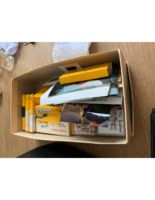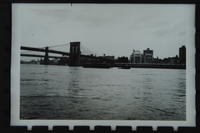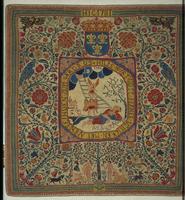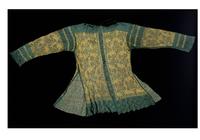-
 Box of Slides
Box of Slides
-
 Process Picture #2
Process Picture #2
-
 Digitization Set Up
Digitization Set Up
-
 Easter 2002
Easter 2002 Mark Polhemus, Margaret Tracey Cronan, Katie Drake, Perry Polhemus, and Jennie Drake sat in the home of Anne Cronan Polhemus for Easter in Midland Park, New Jersey.
-
 Jerpoint Abbey
Jerpoint Abbey A Photograph from a trip to Ireland, The Jerpoint Abbey in Kilkenny Ireland.
-
 Thoor Ballylee Yeats Tower
Thoor Ballylee Yeats Tower Margaret Tracey beside the Yeats Tower in York, Galway, Ireland.
-
 Brooklyn Bridge
Brooklyn Bridge The Brooklyn Bridge, 1972
-
 Richard Cronan
Richard Cronan Richard Cronan on Easter Sunday
-
 The Wedding Party
The Wedding Party Unknown, Margaret Tracey Cronan, Richard Cronan, and Barbara Cronan Morgan sit at the wedding of Richard and Margaret.
-
 Tea Cup Ride
Tea Cup Ride Mary and Ellen Cronan sit in a tea cup in Walt Disney World in Orlando, Florida.
-
 The Car Barn
The Car Barn Margaret Tracey Cronan, Mary Cronan, Margaret Cronan Drake, Ellen Cronan (and Mickey Balloon) and Anne Cronan Polhemus stand in front of the Car Barn. This barn is located on Main Street, USA in The Magic Kingdom Walt Disney World, Orlando, Florida.
-
 Disney Castle
Disney Castle Anne Cronan Polhemus, Margaret Cronan Drake, Mary Cronan, Ellen Cronan sit in front of the Disney Castle in Walt Disney World Orlando, Florida.
-
 Horseshoe Crabs
Horseshoe Crabs Anne Cronan Polhemus, Mary Cronan, Ellen Cronan holding two horseshoe crabs on a beach in Ontario, Canada.
-
 Arctic Watershed
Arctic Watershed Mary Cronan, Ellen Cronan, Margaret Tracey Cronan, Anne Cronan Polhemus, Margaret Cronan Drake sit infront of the Arctic Watershed in Golding, Ontario, Canada.
-
 A Montauk View
A Montauk View An overlook during a trip to Montauk. From right, Ellen Cronan, Margaret Cronan Drake, Margaret Tracey Cronan, Mary Cronan, and Anne Cronan Polhemus.
-
 Big Ben
Big Ben The street before Big Ben in London, England.
-
 Home
Home The Cronan home in Wayne, New Jersey.
-
 A Doe
A Doe A Doe walking along the road, possibly in Montauk.
-
 Bronx Zoo Bear
Bronx Zoo Bear Anne Cronan Polhemus stares at a bear at the Bronx Zoo
-
 Easter Sunday
Easter Sunday Mary Cronan, Anne Cronan Polhemus, Margaret Cronan Polhemus, Ellen Cronan, and Richard Cronan gather for Easter sunday in Elmhurst, Queens, NYC.
-
 Carpet
Carpet This is a hand knit carpet indicative of the requirements journey men had to make in order to become part of any Hand-Knitter's Guilds around Europe. Knitting Guilds developed as early as the 14th century. It is believed to have taken three years of trained to become a journeyman. To gain membership into the guild, journeymen knitters had two produce what are called masterworks. This example from the 18th century probably meets one of the requirements: a wall hanging patterned with flowers. This artisan from Strasbourg went above and beyond with the carpet featuring the figures of Adam and Eve, Jacob's Dream and the inscription "Hilfe wirt gott ferner schicken meinne feinden zum verdus" : God will continue to send help in despite of mine enemies.
-
 Petticoat
Petticoat Mysterious knitted garment due to its intricacy and lack of seeming but size made it unusual for this time and hand knit nature. Knit with 2-ply wool, this petticoat has surface decoration of animals, birds, and trees knitted in purl and plain stitch. There are no seams meaning the piece was knitted in the round (not possible on a frame at the time) with a circumference of over 3 meters. The pattern does not repeat. A true mystery of knitting this is probably the work of a master knitter, possibly for entry into a guild, knit on fine needles with 2-ply wool.
-
 Pair of hose
Pair of hose The stocking stitch got it from items like this. The tops of these hose were designed to fit inside the Cavalier boots popular during the reign of Charles I (reigned 1625-1649). The wide boots were worn with tops turned down. The shape of these hose imitate those of the cloth hose also fashionable during this time even those woolen hose became more popular. The 2-ply wool hose are knitted in stocking stitch, top down, in the round with the knitter casting on 375 stitches which were reduced as the knitter worked down the sock. At 140 stitches the knitter kept this number down the leg of the hose. The heel uses a “Dutch” heel (turned heel) until the piece was cast off at the toes.
-
 Jacket
Jacket This loose fitting jacket was constructed from separated panels of knitting joined together including the sleeves. The floral patterns in stocking stitch and purl were influenced by contemporary woven tapestry designs. Like the previous example, the combination of knit and purl stitches create a very interesting hem of the basket weave stitch. The combination of faded coral colored and gold silks was common in England with a paper of 1712 reporting the theft of “a green silk knit waistcoat with gold and silver flowers all over it.” (Victoria and Albert Museum)
-
 Jacket
Jacket One of the earliest examples of knitted clothing, this silk jacket shows extreme craftsmanship within the variance of stitch. The artisan moved between stocking, purl, and lace techniques to create a variety of effects throughout the piece including the chevron design along the bottom hem. The two pieces were knit flat and then seamed together as indicated by the brown stitching along the sides. This was type of construction was typical of period where most pieces were made in Italy (the center of production) and then assembled by the buyer at the final destination.
 Box of Slides
Box of Slides
 Process Picture #2
Process Picture #2
 Digitization Set Up
Digitization Set Up
 Easter 2002 Mark Polhemus, Margaret Tracey Cronan, Katie Drake, Perry Polhemus, and Jennie Drake sat in the home of Anne Cronan Polhemus for Easter in Midland Park, New Jersey.
Easter 2002 Mark Polhemus, Margaret Tracey Cronan, Katie Drake, Perry Polhemus, and Jennie Drake sat in the home of Anne Cronan Polhemus for Easter in Midland Park, New Jersey. Jerpoint Abbey A Photograph from a trip to Ireland, The Jerpoint Abbey in Kilkenny Ireland.
Jerpoint Abbey A Photograph from a trip to Ireland, The Jerpoint Abbey in Kilkenny Ireland. Thoor Ballylee Yeats Tower Margaret Tracey beside the Yeats Tower in York, Galway, Ireland.
Thoor Ballylee Yeats Tower Margaret Tracey beside the Yeats Tower in York, Galway, Ireland. Brooklyn Bridge The Brooklyn Bridge, 1972
Brooklyn Bridge The Brooklyn Bridge, 1972 Richard Cronan Richard Cronan on Easter Sunday
Richard Cronan Richard Cronan on Easter Sunday The Wedding Party Unknown, Margaret Tracey Cronan, Richard Cronan, and Barbara Cronan Morgan sit at the wedding of Richard and Margaret.
The Wedding Party Unknown, Margaret Tracey Cronan, Richard Cronan, and Barbara Cronan Morgan sit at the wedding of Richard and Margaret. Tea Cup Ride Mary and Ellen Cronan sit in a tea cup in Walt Disney World in Orlando, Florida.
Tea Cup Ride Mary and Ellen Cronan sit in a tea cup in Walt Disney World in Orlando, Florida. The Car Barn Margaret Tracey Cronan, Mary Cronan, Margaret Cronan Drake, Ellen Cronan (and Mickey Balloon) and Anne Cronan Polhemus stand in front of the Car Barn. This barn is located on Main Street, USA in The Magic Kingdom Walt Disney World, Orlando, Florida.
The Car Barn Margaret Tracey Cronan, Mary Cronan, Margaret Cronan Drake, Ellen Cronan (and Mickey Balloon) and Anne Cronan Polhemus stand in front of the Car Barn. This barn is located on Main Street, USA in The Magic Kingdom Walt Disney World, Orlando, Florida. Disney Castle Anne Cronan Polhemus, Margaret Cronan Drake, Mary Cronan, Ellen Cronan sit in front of the Disney Castle in Walt Disney World Orlando, Florida.
Disney Castle Anne Cronan Polhemus, Margaret Cronan Drake, Mary Cronan, Ellen Cronan sit in front of the Disney Castle in Walt Disney World Orlando, Florida. Horseshoe Crabs Anne Cronan Polhemus, Mary Cronan, Ellen Cronan holding two horseshoe crabs on a beach in Ontario, Canada.
Horseshoe Crabs Anne Cronan Polhemus, Mary Cronan, Ellen Cronan holding two horseshoe crabs on a beach in Ontario, Canada. Arctic Watershed Mary Cronan, Ellen Cronan, Margaret Tracey Cronan, Anne Cronan Polhemus, Margaret Cronan Drake sit infront of the Arctic Watershed in Golding, Ontario, Canada.
Arctic Watershed Mary Cronan, Ellen Cronan, Margaret Tracey Cronan, Anne Cronan Polhemus, Margaret Cronan Drake sit infront of the Arctic Watershed in Golding, Ontario, Canada. A Montauk View An overlook during a trip to Montauk. From right, Ellen Cronan, Margaret Cronan Drake, Margaret Tracey Cronan, Mary Cronan, and Anne Cronan Polhemus.
A Montauk View An overlook during a trip to Montauk. From right, Ellen Cronan, Margaret Cronan Drake, Margaret Tracey Cronan, Mary Cronan, and Anne Cronan Polhemus. Big Ben The street before Big Ben in London, England.
Big Ben The street before Big Ben in London, England. Home The Cronan home in Wayne, New Jersey.
Home The Cronan home in Wayne, New Jersey. A Doe A Doe walking along the road, possibly in Montauk.
A Doe A Doe walking along the road, possibly in Montauk. Bronx Zoo Bear Anne Cronan Polhemus stares at a bear at the Bronx Zoo
Bronx Zoo Bear Anne Cronan Polhemus stares at a bear at the Bronx Zoo Easter Sunday Mary Cronan, Anne Cronan Polhemus, Margaret Cronan Polhemus, Ellen Cronan, and Richard Cronan gather for Easter sunday in Elmhurst, Queens, NYC.
Easter Sunday Mary Cronan, Anne Cronan Polhemus, Margaret Cronan Polhemus, Ellen Cronan, and Richard Cronan gather for Easter sunday in Elmhurst, Queens, NYC. Carpet This is a hand knit carpet indicative of the requirements journey men had to make in order to become part of any Hand-Knitter's Guilds around Europe. Knitting Guilds developed as early as the 14th century. It is believed to have taken three years of trained to become a journeyman. To gain membership into the guild, journeymen knitters had two produce what are called masterworks. This example from the 18th century probably meets one of the requirements: a wall hanging patterned with flowers. This artisan from Strasbourg went above and beyond with the carpet featuring the figures of Adam and Eve, Jacob's Dream and the inscription "Hilfe wirt gott ferner schicken meinne feinden zum verdus" : God will continue to send help in despite of mine enemies.
Carpet This is a hand knit carpet indicative of the requirements journey men had to make in order to become part of any Hand-Knitter's Guilds around Europe. Knitting Guilds developed as early as the 14th century. It is believed to have taken three years of trained to become a journeyman. To gain membership into the guild, journeymen knitters had two produce what are called masterworks. This example from the 18th century probably meets one of the requirements: a wall hanging patterned with flowers. This artisan from Strasbourg went above and beyond with the carpet featuring the figures of Adam and Eve, Jacob's Dream and the inscription "Hilfe wirt gott ferner schicken meinne feinden zum verdus" : God will continue to send help in despite of mine enemies. Petticoat Mysterious knitted garment due to its intricacy and lack of seeming but size made it unusual for this time and hand knit nature. Knit with 2-ply wool, this petticoat has surface decoration of animals, birds, and trees knitted in purl and plain stitch. There are no seams meaning the piece was knitted in the round (not possible on a frame at the time) with a circumference of over 3 meters. The pattern does not repeat. A true mystery of knitting this is probably the work of a master knitter, possibly for entry into a guild, knit on fine needles with 2-ply wool.
Petticoat Mysterious knitted garment due to its intricacy and lack of seeming but size made it unusual for this time and hand knit nature. Knit with 2-ply wool, this petticoat has surface decoration of animals, birds, and trees knitted in purl and plain stitch. There are no seams meaning the piece was knitted in the round (not possible on a frame at the time) with a circumference of over 3 meters. The pattern does not repeat. A true mystery of knitting this is probably the work of a master knitter, possibly for entry into a guild, knit on fine needles with 2-ply wool. Pair of hose The stocking stitch got it from items like this. The tops of these hose were designed to fit inside the Cavalier boots popular during the reign of Charles I (reigned 1625-1649). The wide boots were worn with tops turned down. The shape of these hose imitate those of the cloth hose also fashionable during this time even those woolen hose became more popular. The 2-ply wool hose are knitted in stocking stitch, top down, in the round with the knitter casting on 375 stitches which were reduced as the knitter worked down the sock. At 140 stitches the knitter kept this number down the leg of the hose. The heel uses a “Dutch” heel (turned heel) until the piece was cast off at the toes.
Pair of hose The stocking stitch got it from items like this. The tops of these hose were designed to fit inside the Cavalier boots popular during the reign of Charles I (reigned 1625-1649). The wide boots were worn with tops turned down. The shape of these hose imitate those of the cloth hose also fashionable during this time even those woolen hose became more popular. The 2-ply wool hose are knitted in stocking stitch, top down, in the round with the knitter casting on 375 stitches which were reduced as the knitter worked down the sock. At 140 stitches the knitter kept this number down the leg of the hose. The heel uses a “Dutch” heel (turned heel) until the piece was cast off at the toes. Jacket This loose fitting jacket was constructed from separated panels of knitting joined together including the sleeves. The floral patterns in stocking stitch and purl were influenced by contemporary woven tapestry designs. Like the previous example, the combination of knit and purl stitches create a very interesting hem of the basket weave stitch. The combination of faded coral colored and gold silks was common in England with a paper of 1712 reporting the theft of “a green silk knit waistcoat with gold and silver flowers all over it.” (Victoria and Albert Museum)
Jacket This loose fitting jacket was constructed from separated panels of knitting joined together including the sleeves. The floral patterns in stocking stitch and purl were influenced by contemporary woven tapestry designs. Like the previous example, the combination of knit and purl stitches create a very interesting hem of the basket weave stitch. The combination of faded coral colored and gold silks was common in England with a paper of 1712 reporting the theft of “a green silk knit waistcoat with gold and silver flowers all over it.” (Victoria and Albert Museum) Jacket One of the earliest examples of knitted clothing, this silk jacket shows extreme craftsmanship within the variance of stitch. The artisan moved between stocking, purl, and lace techniques to create a variety of effects throughout the piece including the chevron design along the bottom hem. The two pieces were knit flat and then seamed together as indicated by the brown stitching along the sides. This was type of construction was typical of period where most pieces were made in Italy (the center of production) and then assembled by the buyer at the final destination.
Jacket One of the earliest examples of knitted clothing, this silk jacket shows extreme craftsmanship within the variance of stitch. The artisan moved between stocking, purl, and lace techniques to create a variety of effects throughout the piece including the chevron design along the bottom hem. The two pieces were knit flat and then seamed together as indicated by the brown stitching along the sides. This was type of construction was typical of period where most pieces were made in Italy (the center of production) and then assembled by the buyer at the final destination.